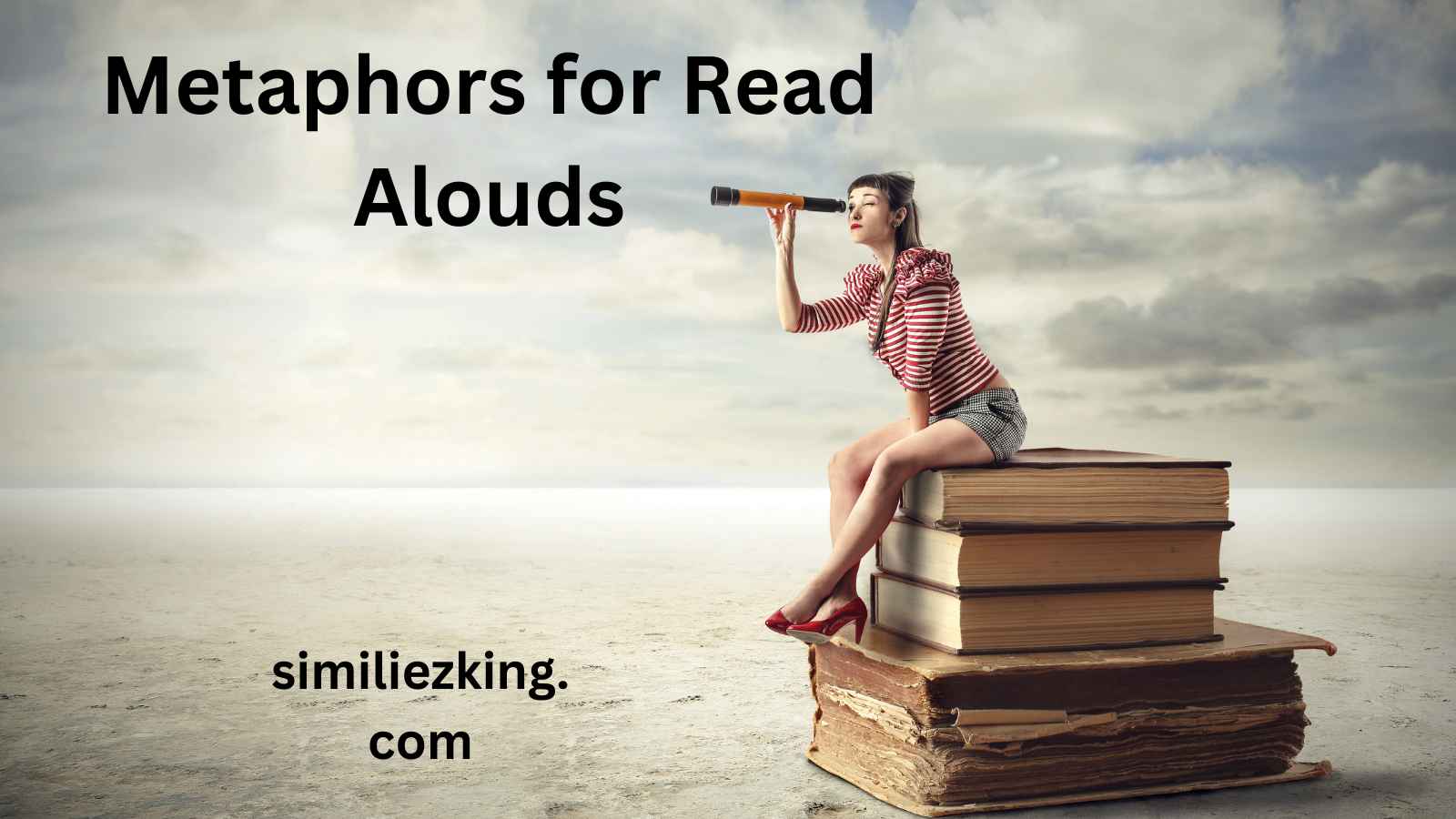Similes and metaphors are the heartbeat of expressive language. They make our words more colorful, comparisons more vivid, and ideas easier to grasp. For young learners, understanding these literary devices can be tricky—unless they’re wrapped in a good story.
That’s where read alouds shine. Carefully chosen children’s books can help students intuitively understand similes and metaphors, making lessons stick.
In this article, we’ll explore over 20 outstanding read-aloud books that naturally introduce and reinforce these literary tools. Whether you’re a teacher, a parent, or a literacy coach, this guide will help you choose the perfect story for your audience and tone.
We’ll also look at how to tailor your language in formal, casual, or humorous ways, and finish with texting examples to keep things modern and social.
What Are Similes and Metaphors?
- Similes use “like” or “as” to compare one thing to another (e.g., “Her smile was as bright as the sun.”)
- Metaphors directly state that one thing is another (e.g., “His mind is a steel trap.”)
These comparisons add depth, emotion, and clarity to language, especially in stories.
Why Use Read-Alouds to Teach Them?
- Contextual Learning: Kids see the figurative language in action.
- Listening Comprehension: Engages students without needing advanced reading skills.
- Discussion Ready: Perfect for pausing and asking questions mid-story.
- Natural Integration: Stories don’t force definitions—they reveal them naturally.
Professional & Classroom-Friendly Read Alouds
1. “Owl Moon” by Jane Yolen
Tone: Gentle, poetic
Use: Ideal for identifying metaphor-rich descriptions of a quiet winter night.
2. “Come On, Rain!” by Karen Hesse
Tone: Narrative, descriptive
Use: Great for similes that describe weather and emotion with poetic elegance.
3. “Quick as a Cricket” by Audrey Wood
Tone: Repetitive, beginner-friendly
Use: Pure simile structure throughout the text—excellent for early learners.
4. “My Dog is as Smelly as Dirty Socks” by Hanoch Piven
Tone: Funny, literal-visual
Use: Combines similes with collage art, helping students visualize comparisons.
5. “Skin Like Milk, Hair of Silk” by Brian P. Cleary
Tone: Educational, playful
Use: A structured book that explains similes and metaphors clearly.
Casual & Creative Read Alouds for Engagement
6. “I’m as Quick as a Cricket” by Audrey Wood
Tone: Light, musical
Use: A repeat favorite, accessible for all elementary grades.
7. “Love You Forever” by Robert Munsch
Tone: Emotional, gentle
Use: Subtle metaphors about life, growth, and love.
8. “The Storm Book” by Charlotte Zolotow
Tone: Natural, flowing
Use: Weather metaphors and mood-setting imagery.
9. “Firefly July: A Year of Very Short Poems” edited by Paul B. Janeczko
Tone: Poetic, seasonal
Use: Offers various poems using figurative language suitable for grades 3-6.
10. “A Bad Case of Stripes” by David Shannon
Tone: Whimsical, metaphor-rich
Use: Metaphors on identity and conformity—great discussion starter.
Humorous & High-Engagement Read Alouds
11. “Parts” by Tedd Arnold
Tone: Silly, relatable
Use: Similes exaggerate a child’s wild misunderstandings about his body.
12. “There’s a Frog in My Throat” by Loreen Leedy and Pat Street
Tone: Zany, educational
Use: Introduces idioms and metaphorical language with literal illustrations.
13. “Piggie Pie!” by Margie Palatini
Tone: Wild, theatrical
Use: Colorful metaphors drive the witch’s quest—engaging for read-alouds.
14. “Meanwhile” by Jason Shiga
Tone: Interactive, visual
Use: Graphic novel format with metaphorical turns and decisions.
15. “Cloudy With a Chance of Meatballs” by Judi Barrett
Tone: Imaginative, hyperbolic
Use: Great to discuss exaggeration, metaphor, and creative narrative.
Unique Books with Simile/Metaphor Lessons Embedded
16. “The Black Book of Colors” by Menena Cottin
Tone: Sensory, abstract
Use: Teaches metaphor through a story about blindness and color.
17. “All the World” by Liz Garton Scanlon
Tone: Philosophical, lyrical
Use: Reflective metaphors about connection and place.
18. “If You Want to See a Whale” by Julie Fogliano
Tone: Quiet, thoughtful
Use: Subtle metaphors in descriptive narrative poetry.
19. “Hello Lighthouse” by Sophie Blackall
Tone: Slow-paced, metaphorical
Use: The lighthouse as metaphor for steadiness, solitude, and change.
20. “Swirl by Swirl: Spirals in Nature” by Joyce Sidman
Tone: Scientific, poetic
Use: Poetic metaphors describing natural phenomena.
How to Choose the Right Book for Your Audience
Tone Matters:
- Professional: Look for structured texts or books with glossaries and author notes.
- Casual: Select fun stories with simple similes repeated often.
- Humorous: Choose books with wild, exaggerated metaphors that kids can laugh about.
Grade Level Guidance:
- K–2: Go for repetition and simple imagery. (e.g., “Quick as a Cricket”)
- Grades 3–5: Add complexity with subtle metaphors and layered meanings.
- Middle Grades: Introduce poetic texts and stories with metaphor themes.
Tips for Reading Aloud with Purpose
- Pause after figurative phrases and ask students what they think it means.
- Re-read striking similes or metaphors.
- Encourage kids to act out or draw the comparisons.
- Ask for real-life versions: “What else could be as fast as a cheetah?”
- Build a class list of favorites from each read-aloud.
11 Google-Optimized Texting Examples
1. Just read Quick as a Cricket with my class—pure simile gold! 🦗
2. My Dog is as Smelly as Dirty Socks = hilarious metaphor moment 😂🐶
3. Today’s read-aloud: Firefly July — perfect for short metaphors in poetry. 🌟📖
4. Teaching similes? Parts by Tedd Arnold gets them every time! 😆🧠
5. Metaphor Monday feat. Owl Moon — calm, quiet, and deep. 🌙❄️
6. Swirl by Swirl is science + metaphor = 🌀 win for Earth Day! 🌍📘
7. Students couldn’t stop laughing at Piggie Pie! Literal witchy metaphors! 🐷🧙♀️
8. We unpacked metaphors in Cloudy with a Chance of Meatballs—total food storm! 🍝🌧️
9. Hello Lighthouse is our metaphor for consistency this week. 🗼❤️
10. The Black Book of Colors = a mind-opening metaphor experience. 🌈🖤
11. Similes that stick? Come On, Rain! still tops the chart! 🌧️👧🏼
Conclusion
Figurative language can seem abstract, but read-alouds bring it to life. From silly metaphors to poetic similes, stories create the perfect bridge between understanding and creativity. With the right book and tone, children don’t just learn—they connect, imagine, and grow.
Use this curated list to elevate your lessons, spark discussions, and make similes and metaphors feel as natural as storytelling itself.



